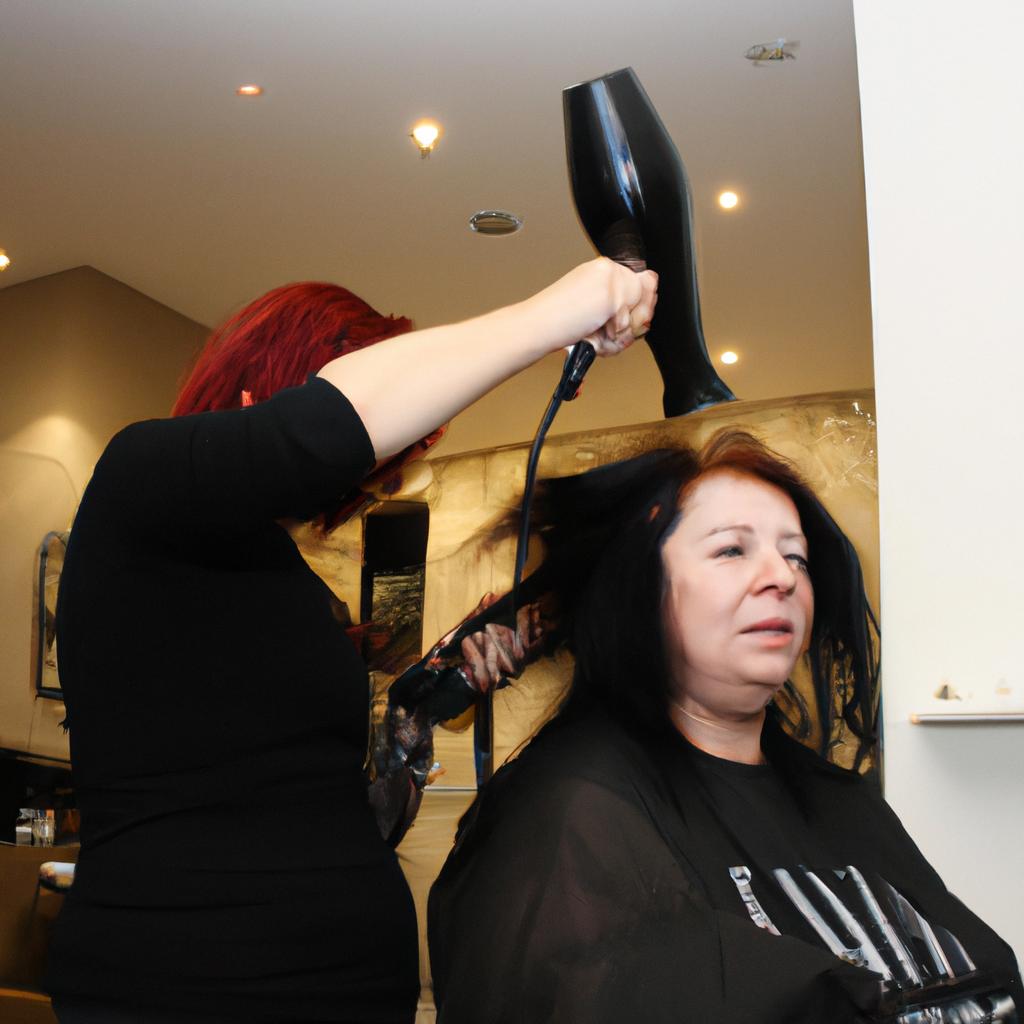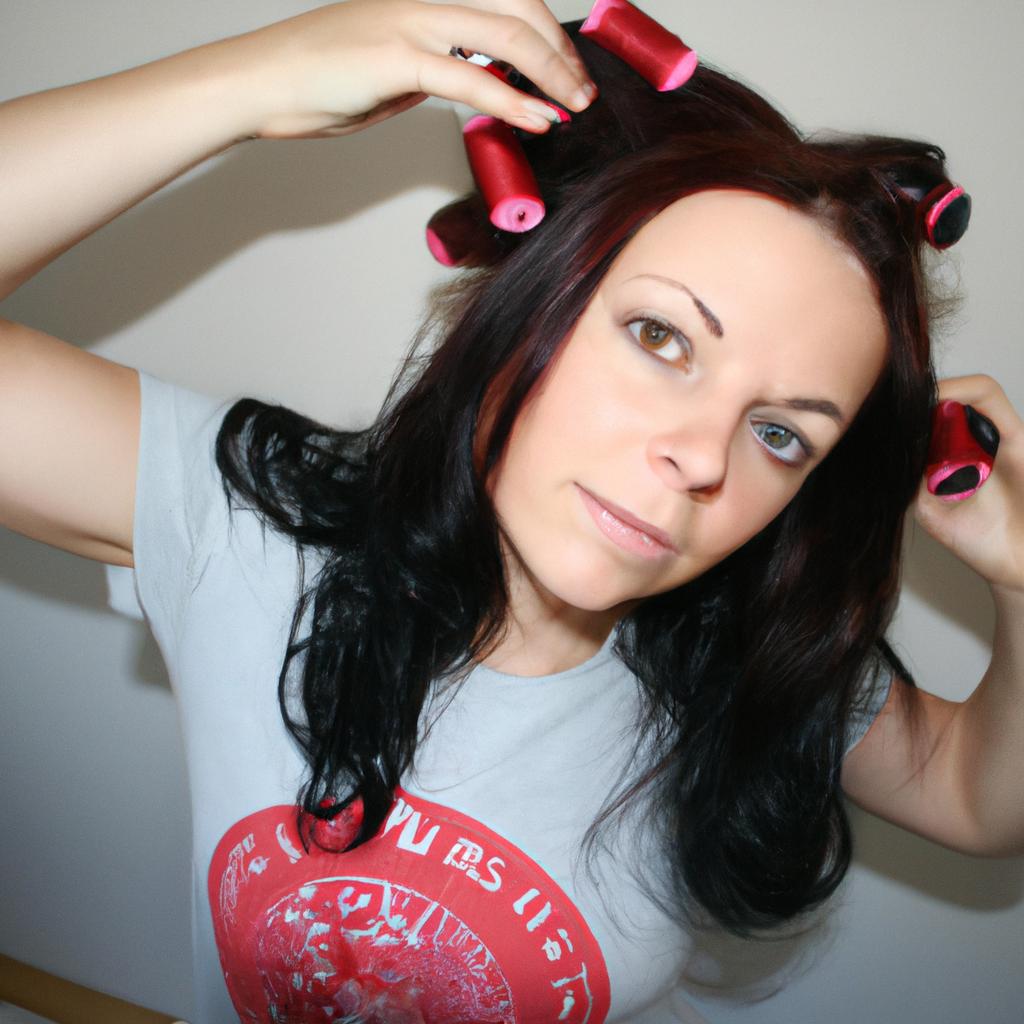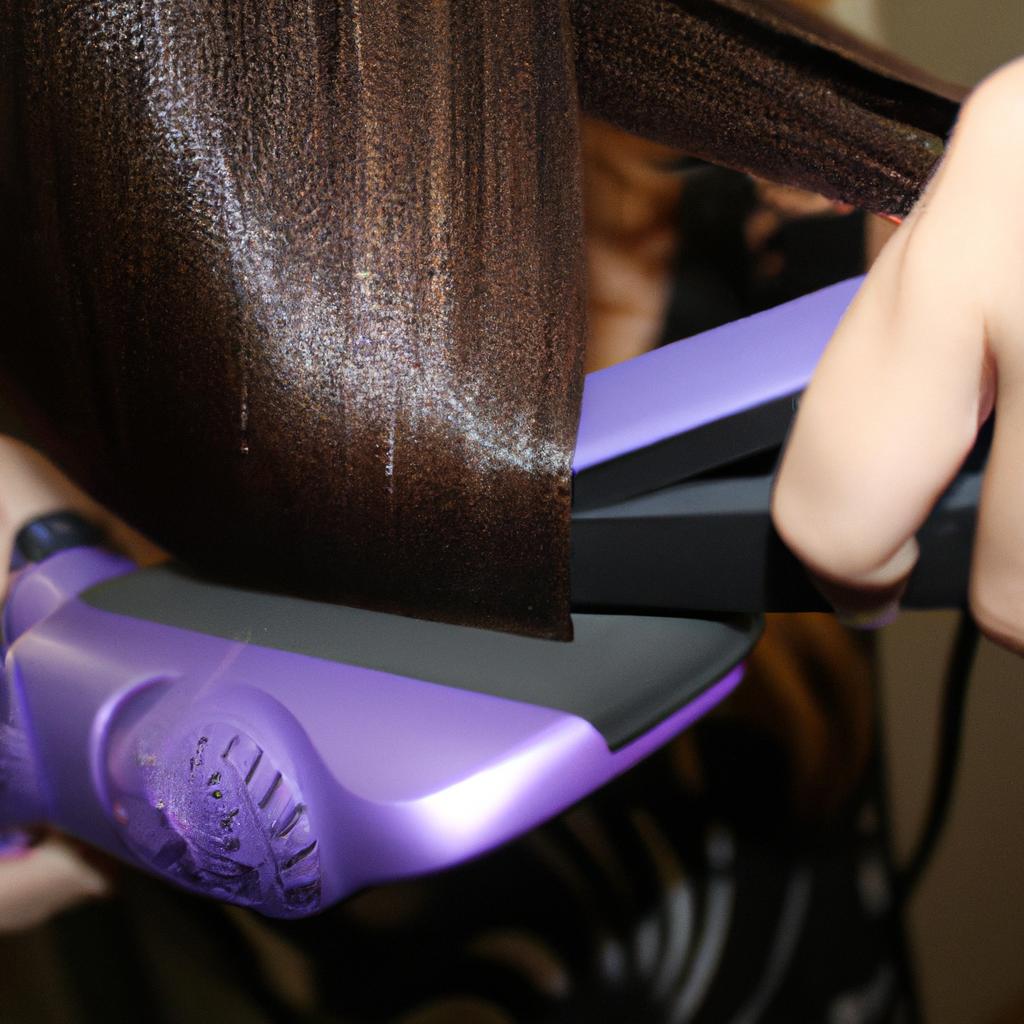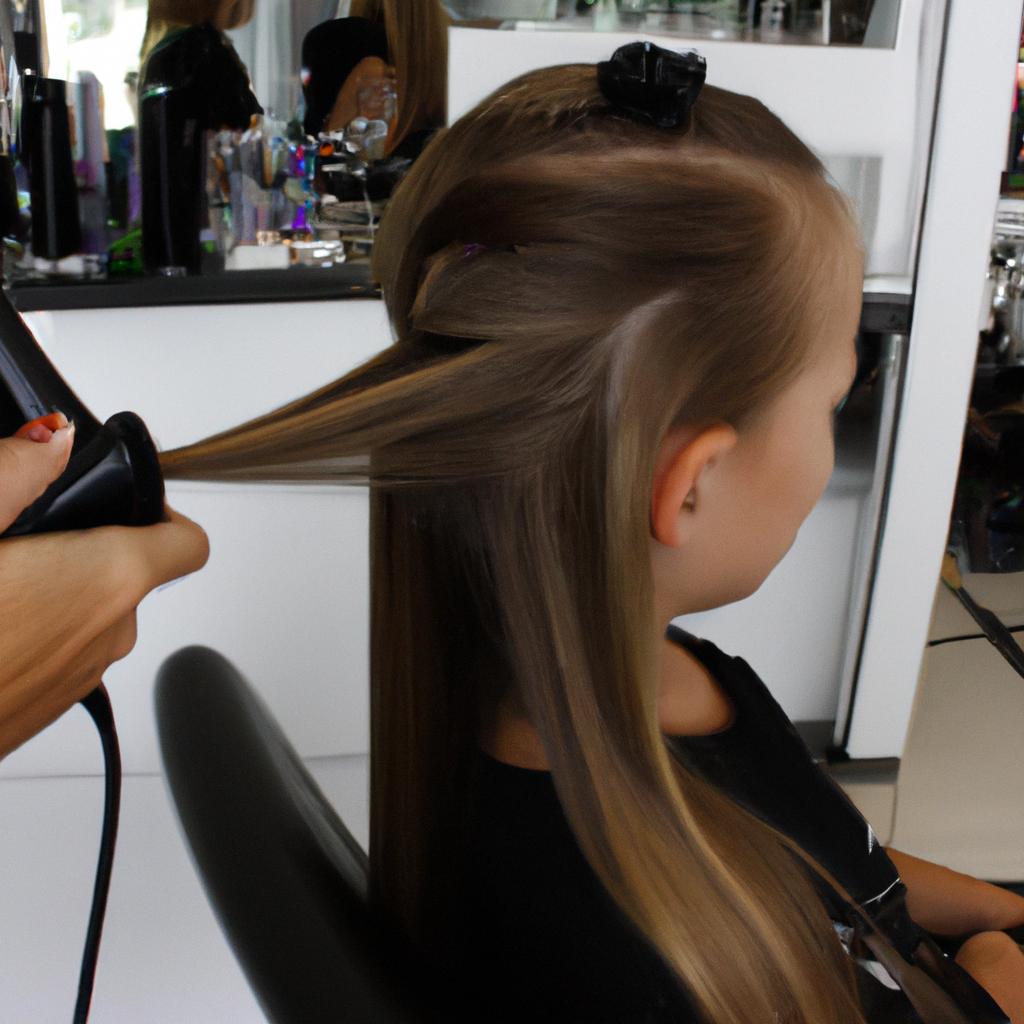The power of the hair dryer in a hairdressing salon is often underestimated, yet it holds immense potential for creating the perfect blowout. Consider the case of Sarah, a client who walked into a salon with frizzy and unruly hair. Through expert manipulation of the hair dryer’s settings and techniques, her stylist was able to transform her locks into a sleek and voluminous masterpiece. This article aims to explore the various aspects that contribute to achieving an impeccable blowout using a hair dryer, highlighting its significance within the realm of hairstyling.
In recent years, there has been an increased focus on understanding the artistry behind the perfect blowout. Hair salons have recognized that this simple tool can be harnessed to create stunning results when utilized effectively. The mastery lies not only in selecting appropriate products but also in skillfully maneuvering the airflow and heat emitted from the hair dryer. By examining different variables such as velocity, temperature distribution, and nozzle attachments, stylists are able to customize their approach based on individual client needs.
Understanding how these factors interact allows professionals to achieve desired outcomes while minimizing damage caused by excessive heat exposure or improper technique. Moreover, recognizing that each client possesses unique hair characteristics presents an opportunity for tailoring blowouts accordingly. With With the right knowledge and expertise, stylists can adapt the hair dryer’s settings to cater to different hair types, textures, and lengths. For example, high-velocity airflow combined with a narrow nozzle attachment is ideal for creating sleek and smooth blowouts on thick or curly hair. On the other hand, a wider nozzle attachment with lower heat settings can be used to add volume and body to fine or limp hair.
Temperature distribution is another crucial aspect that contributes to achieving an impeccable blowout. Professionals understand the importance of using a moderate heat setting rather than cranking up the temperature to its maximum capacity. This helps prevent unnecessary damage and ensures long-lasting results without compromising the health of the hair.
Furthermore, utilizing techniques such as sectioning and elevation allows stylists to manipulate the airflow precisely. By dividing the hair into manageable sections and lifting them away from the scalp while directing the air downwards, they can create lift at the roots and smooth out any frizz or flyaways. Combining these techniques with proper brushwork adds further polish and refinement to the final look.
In addition to technique, product selection plays a vital role in achieving an impeccable blowout. Stylists often use heat protectant sprays or serums before applying heat from the dryer to shield the strands from potential damage. They may also incorporate volumizing mousses or smoothing creams based on individual needs.
Overall, harnessing the power of a professional-grade hair dryer is not just about drying wet hair quickly; it is an art form that requires skillful manipulation of airflow, temperature, technique, and products. With their expertise in this craft, hairstylists have unlocked immense potential within this seemingly simple tool. The ability to transform frizzy and unruly locks into sleek masterpieces demonstrates just how influential a well-executed blowout can be in enhancing one’s overall appearance. Thus, understanding and appreciating the significance of a good quality hair dryer cannot be underestimated in the realm of hairstyling.
Choosing the right hair dryer for salon use
Hair dryers are an essential tool in any hairdressing salon, providing a powerful and efficient way to style and dry clients’ hair. The selection process for choosing the most suitable hair dryer involves considering various factors such as power, heat settings, technology, and ergonomics. To illustrate this point, let’s consider the hypothetical case of a high-end salon that aims to provide its clients with exceptional blowouts.
When selecting a hair dryer for salon use, one crucial factor to consider is its power output. A higher wattage typically indicates more effective drying capabilities. For instance, if our fictional salon desires fast-drying results to accommodate busy schedules without compromising on quality, opting for a hair dryer with at least 1800 watts would be ideal. This ensures that the airflow generated by the dryer is strong enough to expedite the drying process while still maintaining precision styling.
Heat settings also play a significant role when choosing a professional-grade hair dryer. Offering adjustable temperature options allows stylists to cater to different hair types and styles effectively. Our hypothetical salon recognizes the importance of versatility and opts for a hair dryer equipped with multiple heat settings—ranging from low to high temperatures—to ensure optimal performance across various client needs.
To evoke an emotional response in both stylists and potential readers alike, here is a bullet-point list showcasing some advantages of investing in a top-quality salon hair dryer:
- Enhanced efficiency: Powerful airflow reduces overall drying time.
- Improved hairstyling outcomes: Precise control over heat settings enables versatile styling options.
- Client satisfaction: Faster drying leads to happier customers who can enjoy their styled locks sooner.
- Salon reputation: Utilizing professional-grade equipment demonstrates commitment to excellence.
Additionally, incorporating tables into academic writing can help present information concisely while still appealing visually. Here is an example of how we may incorporate a table into this section:
| Hair Dryer Feature | Benefits |
|---|---|
| High wattage | Faster drying time, catering to busy salon schedules. |
| Adjustable heat settings | Versatility in styling different hair types and textures. |
| Ergonomic design | Comfort for the stylist during extended use periods. |
| Advanced technology | Enhanced performance and long-term durability of the dryer. |
In conclusion, choosing the right hair dryer for salon use involves considering factors such as power output, heat settings, ergonomics, and advanced technology. By investing in a high-quality hair dryer that meets these criteria, our hypothetical upscale salon can ensure efficient blowouts while satisfying clients’ needs and maintaining its reputation for excellence.
Transitioning into the next section about “Prepping the hair before blow-drying,” it is essential to establish a seamless flow between sections. Understanding how to prepare the hair adequately sets the foundation for achieving exceptional results when utilizing the chosen hair dryer’s capabilities.
Prepping the hair before blow drying
Transitioning smoothly from our previous discussion on selecting the right hair dryer, we now delve into another crucial aspect of achieving a flawless blowout – prepping the hair before blow drying. To illustrate its significance, let’s consider the hypothetical case study of a salon client with thick, unruly hair.
Before commencing the blow-drying process, it is essential to prepare the hair adequately. This involves several key steps:
-
Cleansing and conditioning: Start by gently shampooing the hair using products suitable for your client’s specific needs. Follow this up with a nourishing conditioner that helps maintain moisture balance and enhances manageability.
-
Detangling: Untangle any knots or snarls in the hair using a wide-toothed comb or brush designed specifically for wet hair. Begin at the ends and work upwards towards the roots to minimize breakage.
-
Applying heat protectant: Shielding the strands from potential damage caused by high heat is crucial during blowouts. Apply a heat protectant spray evenly throughout damp hair to create a protective barrier against excessive heat exposure.
-
Sectioning: Divide the hair into manageable sections using sectioning clips or elastics. This technique allows for more precise styling and ensures thorough drying throughout each strand.
Implementing these preparatory steps not only sets an ideal foundation for efficient styling but also minimizes potential damage while maximizing desired results.
To further emphasize their importance, here are some emotional benefits associated with effectively prepping your clients’ hair:
- Enhanced confidence: A well-prepared canvas instills confidence within individuals as they step out of your salon sporting perfectly styled locks.
- Professional touch: By meticulously addressing every detail during preparation, you showcase your expertise and professionalism as a skilled hairstylist.
- Increased satisfaction: Clients appreciate knowing that their stylist takes extra care to ensure their comfort and provide exceptional service.
- Long-lasting style: Properly prepped hair allows for a blowout that withstands the test of time, leaving clients satisfied with their salon experience long after they leave your chair.
In our next section, we will explore the technique of sectioning the hair for efficient styling, an integral step towards achieving impeccable blowouts. By dividing the hair into manageable sections, you can ensure precision and maintain control throughout the styling process.
Sectioning the hair for efficient styling
Having prepped the hair, the next crucial step in achieving a perfect blowout is proper sectioning. By dividing the hair into manageable sections, hairstylists can ensure efficient styling and achieve consistent results. Let’s explore the importance of sectioning in detail.
Example Case Study:
Consider a scenario where a client with long, thick hair visits a salon seeking a voluminous blowout. Without sectioning the hair properly, it would be challenging to evenly distribute heat and product throughout each strand, resulting in an inconsistent finish. However, by following appropriate sectioning techniques, such as dividing the hair horizontally and vertically, our stylist can create precise sections that allow for better control during styling.
Efficient Sectioning Techniques:
- Horizontal Sections: Dividing the hair horizontally helps maintain control while working on different layers of strands. This technique ensures even distribution of heat and product from roots to ends.
- Vertical Sections: Creating vertical subsections allows stylists to focus on specific areas or target particular styles. For instance, if adding curls or waves using a round brush, smaller vertical sections enable more precision.
- Clip Placement: Strategically placing clips at various points along each section keeps unstyled hair out of the way. Additionally, this prevents tangling and minimizes disruption when moving between different parts of the head.
- Gradual Release: Releasing one section at a time rather than removing all clips simultaneously avoids confusion and ensures focused styling without missing any areas.
Emotional Bullet Points:
The benefits of effective sectioning are manifold; it not only enhances efficiency but also contributes to overall client satisfaction:
- Improved Control: Properly divided sections offer greater control over individual strands, enabling stylists to achieve desired styles accurately.
- Enhanced Volume: Strategic placement of sections aids in creating volume precisely where needed, providing clients with fuller-looking hairstyles.
- Consistent Results: By ensuring equal treatment for each section, hairstylists can deliver consistent results throughout the hair, avoiding any noticeable discrepancies.
- Time Optimization: Efficient sectioning streamlines the blow drying process, enabling stylists to work more effectively and reduce overall styling time.
Emotional Table:
| Benefits of Effective Sectioning | How it Enhances Styling |
|---|---|
| Improved Control | Accurate Styles |
| Enhanced Volume | Fuller-looking Hair |
| Consistent Results | Uniform Hairstyles |
| Time Optimization | More Efficient Process |
Mastering the proper blow drying technique is fundamental in achieving flawless results. By combining efficient sectioning with skillful manipulation of heat and airflow, hairstylists can unlock the true potential of a hairdryer and create stunning hairstyles that leave clients feeling confident and satisfied.
Mastering the proper blow drying technique
Transitioning smoothly from our previous discussion on efficiently sectioning the hair, let us now delve into mastering the proper blow drying technique. To illustrate its effectiveness, imagine a case where a client with thick and frizzy hair walks into your salon seeking sleek and shiny locks for an upcoming event. With the right approach to blow drying, you can transform their unruly mane into a stunning masterpiece.
To ensure outstanding results, it is essential to follow these key steps:
-
Control heat distribution: Begin by setting your hair dryer to medium heat and adjusting as needed based on the client’s hair type and thickness. This prevents excessive damage caused by high temperatures while allowing even heat distribution throughout the strands.
-
Maintain an appropriate distance: Hold the nozzle of the hair dryer at least 6-8 inches away from the head, ensuring that hot air is dispersed evenly without scorching or singeing any particular area. This distance also helps in minimizing direct contact between the scalp and heated airflow.
-
Use professional styling brushes: Employ round brushes made specifically for blowouts to achieve optimal control during styling. The bristles’ design assists in smoothing out tresses, promoting shine, and creating volume where desired.
-
Work systematically through sections: Divide the hair into manageable segments using clips or pins before styling each portion individually. Starting from the nape of the neck, work your way up towards the crown while focusing on one section at a time—this ensures consistent results across all areas of the head.
Incorporating these techniques will contribute significantly to success in achieving flawless blowouts consistently for your clients.
Now that we have explored how to perfect your blow drying skills, it is crucial to address another vital aspect of protecting hair during this process – utilizing heat protectant products effectively. Let us move forward with understanding why these protective measures are crucial for maintaining healthy locks while undergoing heat styling methods.
Using heat protectant products for hair safety
Imagine a scenario where a client walks into your hairdressing salon with flat, lifeless hair. They are seeking that perfect blowout to give their hair volume and bounce. As a skilled stylist, it is crucial to master the proper blow drying technique in order to achieve exceptional results. In this section, we will delve deeper into the art of blow drying, exploring key techniques that can transform lackluster locks into magnificent manes.
To begin, let’s discuss the importance of sectioning the hair before starting the blow drying process. By dividing the hair into manageable sections, you can ensure thorough drying without compromising on quality. Start by parting the hair horizontally from ear to ear and securing the top half with clips or pins. Working on one section at a time allows for better control and precision while preventing tangles and confusion.
Once you have successfully partitioned the hair, it is essential to understand the correct angle and airflow direction when using a hairdryer. Positioning the nozzle downward along each strand helps smooth out cuticles effectively, resulting in sleeker strands. Aim for an angle pointing away from roots towards ends as this encourages natural lift and movement within the hairstyle.
Now, let’s explore some key tips for achieving optimal results during your blow drying sessions:
- Use a round brush: This versatile tool not only aids in detangling but also adds body and creates beautiful waves or curls.
- Maintain consistent heat levels: Adjust your dryer setting according to different areas of dampness within each section.
- Keep distance between dryer and hair: Maintain around 6 inches between your dryer nozzle and the hair to avoid excessive heat damage.
- Finish off with cool air: After styling each section, blast cold air over it briefly to set style and add shine.
To further enhance your understanding of these techniques, refer to Table 1 below which provides visual representation:
Table 1:
| Technique | Benefits |
|---|---|
| Sectioning | – Easier control |
| – Thorough drying | |
| Angle & Airflow | – Smooth cuticles |
| Direction | – Lift and movement |
By following these guidelines, you can achieve that picture-perfect blowout your clients desire. Next, we will explore the use of heat protectant products to ensure hair safety during the styling process.
Understanding the proper techniques is just one aspect of creating a flawless blowout. By incorporating various finishing touches, you can elevate the overall look and leave your clients feeling confident and satisfied.
Finishing touches for a flawless blowout
Transition from Previous Section:
Having established the importance of using heat protectant products to ensure hair safety, it is now crucial to delve into the next step in achieving a perfect blowout. By mastering the technique and utilizing various tools at their disposal, hairstylists can unleash the full potential of the hair dryer in their salon.
The Art of Precision
To begin with, let us consider an example scenario where a client with thick, frizzy hair walks into a salon seeking a sleek and polished look for a special event. This case study will help illuminate the significance of employing proper techniques during a blowout session. With careful attention to detail, the stylist should first divide the client’s hair into sections before starting to dry each section individually. This ensures that every strand receives equal exposure to heat without excessive damage.
Essential Tools for an Effortless Finish
During this process, there are several key tools that professionals employ to achieve optimal results:
- A round brush: Allows for better control when styling and helps create volume or smoothness depending on its size.
- Hair clips: Keep unblown sections away while focusing on one area at a time.
- Diffuser attachment: Ideal for clients with curly or wavy hair as it reduces frizz and enhances natural texture.
- Nozzle attachment: Directs airflow precisely, aiding in creating sleek styles or adding volume at the roots.
The combination of these tools along with skillful hand movements ensures maximum effectiveness during a blowout session.
Balancing Heat and Cool Air
Finally, it is essential to maintain balance throughout the drying process by alternating between hot air and cool blasts. While warm air aids in shaping and setting desired hairstyles, cold air helps seal cuticles, giving locks added shine and longevity. This interplay between different temperature settings not only protects against overheating but also promotes healthier hair.
| Benefits of a Perfect Blowout |
|---|
| – Boosts confidence and self-esteem |
| – Enhances the overall appearance |
| – Provides a professional touch |
| – Extends the longevity of hairstyles |
In conclusion, mastering the technique of achieving a perfect blowout involves precise execution, employing essential tools, and strategically balancing heat and cool air. By following these steps, hairstylists can provide clients with flawless results that boost their confidence and enhance their overall appearance. The emotional satisfaction derived from having an impeccable hairstyle is not only limited to special occasions but extends to daily life as well. Ultimately, it is through dedication and expertise in this art form that professionals harness the full power of the hair dryer in transforming individuals’ looks.




